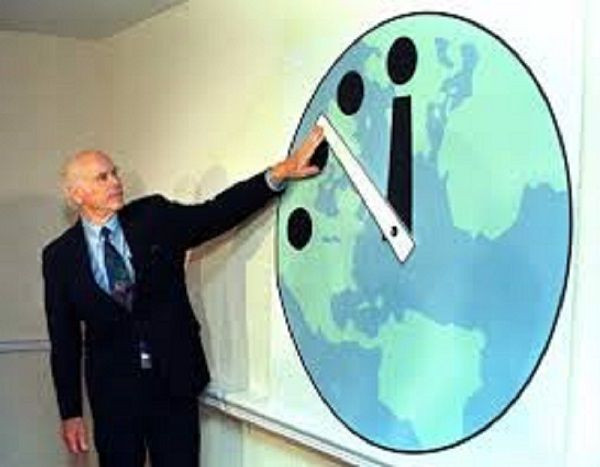It’s still 3 minutes to ‘end-of-the-world,’ warns Bulletin of the Atomic Scientists’ Doomsday Clock

Failure of global leaders to focus their efforts and attention to reduce the extreme danger from nuclear weapons and climate change has led the Bulletin of the Atomic Scientists to keep the minute hand of the Doomsday Clock to 3 minutes. The ticking hands theoretically indicate how close is an Apocalypse, or the end-of-the-world.
Although the Doomsday Clock is a gimmick of the Bulletin of the Atomic Scientists, an anti-nuclear proliferation group, it is still a good representation of the risks from various threats to Earth, particularly the potential of a nuclear war, points out Gizmondo. In a statement, the group explains, “When we call these dangers existential, that is exactly what we mean: They threaten the very existence of civilization and therefore should be the first order of business for leaders who care about their constituents and their countries.”
The 3-minutes-to-midnight time, though, is not the closest to an “Apocalypse” since it was moved to 2 minutes in 1953 when the Soviet Union conducted hydrogen bomb tests after the US. Some people, however, may consider the warnings as over-the-top or foolish since the last time a nuclear weapon was used was in 1945 when the Allied Forces used the atomic bomb on the Japanese cities of Hiroshima and Nagasaki.
In retaining the 3 minutes, the scientists cite some positive strides from two of the most pressing threats to humanity’s existence. These are nuclear weapons and climate change when Iran agreed to limit its nuclear programme and the Paris climate change agreement document was signed, notes the Bulletin.
Almost two years of negotiations between Iran and six world powers resulted in Iran agreeing in June 2015 to limit the country’s nuclear ambition which prevents Tehran from developing nuclear weapons. Before 2015 ended, almost 200 nations inked a document that commits countries to cut their carbon dioxide emissions to prevent an increase in world temperature to below 2 degrees Celsius above pre-industrial level.
But these two events are only “small bright spots” as the potential for catastrophe still looms because of the continued tensions between the US and Russia, the conflict in Ukraine and the civil war in Syria. In not moving the minute hand of the clock, the scientists stress it is the closest to catastrophe “since the early days of above-ground hydrogen bomb testing.”





















